The Influence of CO2-Cured Incinerated Waste Fly Ash on the Performance of Reactive Powder Concrete
Abstract
1. Introduction
2. Experimental Section
2.1. Raw Materials
2.2. Sample Manufacturing
2.3. Measurement of Basic Performances
2.4. Thermal Analysis and Scanning Electron Microscope
2.5. Mercury Intrusion Analysis
3. Results and Discussion
3.1. Rheological Parameters and Setting Time of Fresh RPC
3.2. Mechanical Performance
3.3. The Leaching of Toxic Metal Elements
3.4. Microscopic Analysis
4. Conclusions
Author Contributions
Funding
Institutional Review Board Statement
Informed Consent Statement
Data Availability Statement
Conflicts of Interest
References
- Avila-López, U.; Almanza-Robles, J.M.; Escalante-García, J. Investigation of novel waste glass and limestone binders using statistical methods. Constr. Build. Mater. 2015, 82, 296–303. [Google Scholar] [CrossRef]
- Chen, L.; Wang, Y.; Wang, L.; Zhang, Y.; Li, J.; Tong, L.; Hu, Q.; Dai, J.-G.; Tsang, D.C.W. Stabilisation/solidifification of municipal solid waste incineration fly ash by phosphate-enhanced calcium aluminate cement. J. Hazard. Mater. 2021, 408, 124404. [Google Scholar] [CrossRef] [PubMed]
- Ren, J.; Hu, L.; Dong, Z.; Tang, L.; Xing, F.; Liu, J. Effect of silica fume on the mechanical property and hydration characteristic of alkali-activated municipal solid waste incinerator (MSWI) fly ash. J. Clean. Prod. 2021, 295, 126317. [Google Scholar] [CrossRef]
- Tian, X.; Rao, F.; Morales-Estrella, R.; Song, S. Effects of aluminum dosage on gel formation and heavy metal immobilization in alkali-activated municipal solid waste incineration fly ash. Energy Fuels 2020, 34, 4727–4733. [Google Scholar] [CrossRef]
- Zhang, Y.; Wang, L.; Chen, L.; Ma, B.; Zhang, Y.; Ni, W.; Tsang, D. Treatment of municipal solid waste incineration flfly ash: State-of-the-art technologies and future perspectives. J. Hazard. Mater. 2021, 411, 125132. [Google Scholar] [CrossRef] [PubMed]
- Alderete, N.; Joseph, A.; Van den Heede, P.; Matthys, S.; De Belie, N. Effective and sustainable use of municipal solid waste incineration bottom ash in concrete regarding strength and durability. Resour. Conserv. Recycl. 2021, 167, 105356. [Google Scholar] [CrossRef]
- Xing, J.; Tang, Q.; Gan, M.; Ji, Z.; Fan, X.; Sun, Z.; Chen, X. Co-treatment of municipal solid waste incineration fly ash (MSWI FA) and municipal sludge: A innovative method to improve sludge dewatering with fly ash dichlorination. J. Environ. Manag. 2023, 332, 117403. [Google Scholar] [CrossRef]
- Mandpe, A.; Yadav, N.; Paliya, S.; Tyagi, L.; Yadav, B.R.; Singh, L.; Kumar, S.; Kumar, R. Exploring the synergic effect of fly ash and garbage enzymes on biotransformation of organic wastes in in-vessel composting system. Bioresour. Technol. 2021, 322, 124557. [Google Scholar] [CrossRef]
- Ferraro, A.; Ducman, V.; Colangelo, F.; Korat, L.; Spasiano, D.; Farina, I. Production and characterization of lightweight aggregates from municipal solid waste incineration fly-ash through single and double-step pelletization process. J. Clean. Prod. 2023, 383, 135275. [Google Scholar] [CrossRef]
- Ramesh Kumar, G.; Bharani, S.; Anupriya, R.; Jeevitha, V.; Gnanajothi, G. Influence of electronic waste and fly ash in strength and durability properties of concrete. Mater. Today Proc. 2022, 62, 2230–2234. [Google Scholar] [CrossRef]
- Cui, L.; Wang, H. Influence of waste fly ash on the rheological properties of fresh cement paste and the following electrical performances and mechanical strengths of hardened specimens. Coatings 2021, 11, 1558. [Google Scholar] [CrossRef]
- Cui, L.; Wang, H. Research on the mechanical strengths and the following corrosion resistance of inner steel bars of RPC with rice husk ash and waste fly ash. Coatings 2021, 11, 1480. [Google Scholar] [CrossRef]
- Du, Y.; Hao, W.; Shi, F.; Wang, H.; Xu, F.; Du, T. Investigations of the mechanical properties and durability of reactive powder concrete containing waste fly ash. Buildings 2022, 12, 560. [Google Scholar] [CrossRef]
- Witoon, T.; Numpilai, T.; Nijpanich, S.; Chanlek, N.; Kidkhunthod, P.; Cheng, C.K.; Ng, K.; Vo, D.-V.N.; Ittisanronnachai, S.; Wattanakit, C.; et al. Enhanced CO2 hydrogenation to higher alcohols over K-Co promoted In2O3 catalysts. Chem. Eng. J. 2022, 431, 133211. [Google Scholar] [CrossRef]
- Sharma, R.; Kim, H.; Pei, J.; Jang, J.G. Dimensional stability of belite-rich cement subject to early carbonation curing. J. Build. Eng. 2023, 63, 105545. [Google Scholar] [CrossRef]
- Xu, F.; Chang, R.; Zhang, D.; Liang, Z.; Wang, K.; Wang, H. Improvement of CO2-cured sludge ceramsite on the mechanical performances and corrosion resistance of cement concrete. Materials 2022, 15, 5758. [Google Scholar] [CrossRef] [PubMed]
- Peng, L.; Yang, J.; Wang, H.; Jin, X. The influence of CO2 Curing on the mechanical performance and the corresponding chloride ion resistance of alkali-activated compound mineral admixtures. Coatings 2022, 12, 1920. [Google Scholar] [CrossRef]
- Khan, R.I.; Ashraf, W.; Olek, J. Amino acids as performance-controlling additives in carbonation-activated cementitious materials. Cement Concr. Res. 2021, 147, 106501. [Google Scholar] [CrossRef]
- Siddique, S.; Naqi, A.; Jang, J.G. Influence of water to cement ratio on CO2 uptake capacity of belite-rich cement upon exposure to carbonation curing. Cem. Concr. Compos. 2020, 111, 103616. [Google Scholar] [CrossRef]
- Liang, J.; Zhu, H.; Chen, L.; Qinglin, X.; Ying, G. Rebar corrosion investigation in rubber aggregate concrete via the chloride electro-accelerated test. Materials 2019, 12, 862. [Google Scholar] [CrossRef]
- Ogawa, Y.; Bui, P.T.; Kawai, K.; Sato, R. Effects of porous ceramic roof tile waste aggregate on strength development and carbonation resistance of steam-cured fly ash concrete. Construct. Build. Mater. 2020, 236, 117462. [Google Scholar] [CrossRef]
- Khan, R.I.; Haque, M.I.; Ashraf, W.; Shah, S.; Saleh, N. Role of biopolymers in enhancing multiscale characteristics of carbonation-cured cementitious composites. Cem. Concr. Compos. 2022, 134, 104766. [Google Scholar] [CrossRef]
- Sarmiento, L.E.M.; Clavier, K.A.; Townsend, T.G. Trace element release from combustion ash co-disposed with municipal solid waste. Chemosphere 2020, 252, 126436. [Google Scholar] [CrossRef] [PubMed]
- Song, Z.; Zhang, X.; Tan, Y.; Zeng, Q.; Hua, Y.; Wu, X.; Li, M.; Liu, X.; Luo, M. An all-in-one strategy for municipal solid waste incineration fly ash full resource utilization by heat treatment with added kaolin. J. Environ. Manag. 2023, 329, 117074. [Google Scholar] [CrossRef]
- Lv, Y.; Yang, L.; Wang, J.; Zhan, B.; Xi, Z.; Qin, Y.; Liao, D. Performance of ultra-high-performance concrete incorporating municipal solid waste incineration fly ash. Case Stud. Constr. Mater. 2022, 17, e01155. [Google Scholar] [CrossRef]
- Wong, G.; Fan, X.; Gan, M.; Ji, Z.; Ye, H.; Zhou, Z.; Wang, Z. Resource utilization of municipal solid waste incineration fly ash in iron ore sintering process: A novel thermal treatment. J. Clean. Prod. 2020, 263, 121400. [Google Scholar] [CrossRef]
- JGJ/T 70-2009; Standard for Test Method of Basic Properties of Construction Mortar. Ministry of Housing and Urban-Rural Development of the People’s Republic of China: Beijing, China, 2009.
- Zhu, J.; Qu, Z.; Liang, S.; Li, B.; Du, T.; Wang, H. The macro-scopic and microscopic properties of cement paste with carbon dioxide curing. Materials 2022, 15, 1578. [Google Scholar] [CrossRef]
- GB/T 17671-1999; Method of Testing Cements-Determination of Strength. The State Bureau of Quality and Technical Supervision: Beijing, China, 1999.
- Wang, S.; Guo, W.; Bai, Y.; Pan, H.; Qiu, Y.; Xue, C.; Zhao, Q. Preparation and characterization of mortar specimens based on municipal solid waste incineration fly ash-activated slag. J. Build. Eng. 2023, 69, 106254. [Google Scholar] [CrossRef]
- Liu, J.; Wang, Z.; Xie, G.; Li, Z.; Fan, X.; Zhang, W.; Xing, F.; Tang, L.; Ren, J. Resource utilization of municipal solid waste incineration fly ash—Cement and alkali-activated cementitious materials: A review. Sci. Total Environ. 2022, 852, 158254. [Google Scholar] [CrossRef]
- Dong, P.; Liu, J.; Wang, H.; Yuan, H.; Wang, Q. Sustainable municipal solid waste incineration fly ash (MSWIFA) alkali-activated materials in construction: Fabrication and performance. Nanobuild 2022, 14, 43–52. [Google Scholar] [CrossRef]
- Tang, P.; Florea, M.V.A.; Spiesz, P.; Brouwers, H.J.H. Application of thermally activated municipal solid waste incineration (MSWI) bottom ash fines as binder substitute. Cem. Concr. Compos. 2016, 70, 194–205. [Google Scholar] [CrossRef]
- AL-Ameeri, A.S.; ImranRafifiq, M.; Tsioulou, O.; Rybdylova, O. Impact of climate change on the carbonation in concrete due to carbon dioxide ingress: Experimental investigation and modelling. J. Build. Eng. 2021, 44, 102594. [Google Scholar] [CrossRef]
- Smirnov, V.G.; Manakov, A.Y.; Dyrdin, V.V.; Ismagilov, Z.R.; Mikhailova, E.S.; Rodionova, T.V. The formation of carbon dioxide hydrate from water sorbed by coals. Fuel 2018, 228, 123–131. [Google Scholar] [CrossRef]
- Qin, L.; Gao, X.; Chen, T. Influence of mineral admixtures on carbonation curing of cement paste. Constr. Build. Mater. 2019, 212, 653–662. [Google Scholar] [CrossRef]
- Li, Z.; Zhang, W.; Jin, H.; Fan, X.; Liu, J.; Xing, F.; Tang, L. Research on the durability and sustainability of an artificial lightweight aggregate concrete made from municipal solid waste incinerator bottom ash (MSWIBA). Const. Build. Mater. 2023, 365, 129993. [Google Scholar] [CrossRef]
- Liu, B.; Yang, L.; Shi, J.; Zhang, S.; Yalçınkaya, Ç.; Alshalif, A.F. Effect of curing regime on the immobilization of municipal solid waste incineration fly ash in sustainable cement mortar. Environ. Pollut. 2023, 317, 120839. [Google Scholar] [CrossRef]
- Xiang, J.; Qiu, J.; Wang, F.; Li, Z.; Gu, X. Utilization of bioactivated incineration bottom ash in cement binder for mortar harmless treatment and performance improvement. J. Build. Eng. 2022, 57, 104980. [Google Scholar] [CrossRef]
- Tripathy, A.; Acharya, P.K. Characterization of bagasse ash and its sustainable use in concrete as a supplementary binder-A review. Const. Build. Mater. 2022, 322, 126391. [Google Scholar] [CrossRef]
- Matalkah, F. Recycling of hazardous medical waste ash toward cleaner utilization in concrete mixtures. J. Clean. Prod. 2023, 400, 136736. [Google Scholar] [CrossRef]
- Zha, X.; Ning, J.; Saafi, M.; Dong, L.; Dassekpo, J.B.M.; Ye, J. Effect of supercritical carbonation on the strength and heavy metal retention of cement-solidified fly ash. Cem. Concr. Res. 2019, 120, 36–45. [Google Scholar] [CrossRef]
- Ding, Y.; Xi, Y.; Gao, H.; Wang, J.; Wei, W.; Zhang, R. Porosity of municipal solid waste incinerator bottom ash effects on asphalt mixture performance. J. Clean. Prod. 2022, 369, 133344. [Google Scholar] [CrossRef]
- Xie, W.; Li, H.; Yang, M.; He, L.; Li, H. CO2 capture and utilization with solid waste. J. Clean. Prod. 2022, 3, 199–209. [Google Scholar] [CrossRef]
- Dong, P.; Ding, W.; Yuan, H.; Wang, Q. 3D-printed polymeric lattice-enhanced sustainable municipal solid waste incineration fly ash alkali-activated cementitious composites. Dev. Built. Environ. 2022, 12, 100101. [Google Scholar] [CrossRef]
- Wu, X.; Gu, F.; Su, C.; Wang, W.; Pu, K.; Shen, D.; Long, Y. Preparing high-strength ceramsite from ferronickel slag and municipal solid waste incineration fly ash. Ceram. Int. Part A 2022, 48, 34265–34272. [Google Scholar] [CrossRef]
- Assi, A.; Bilo, F.; Zanoletti, A.; Ponti, J.; Valsesia, A.; La Spina, R.; Zacco, A.; Bontempi, E. Zero-waste approach in municipal solid waste incineration: Reuse of bottom ash to stabilize fly ash. J. Clean. Prod. 2020, 245, 118779. [Google Scholar] [CrossRef]
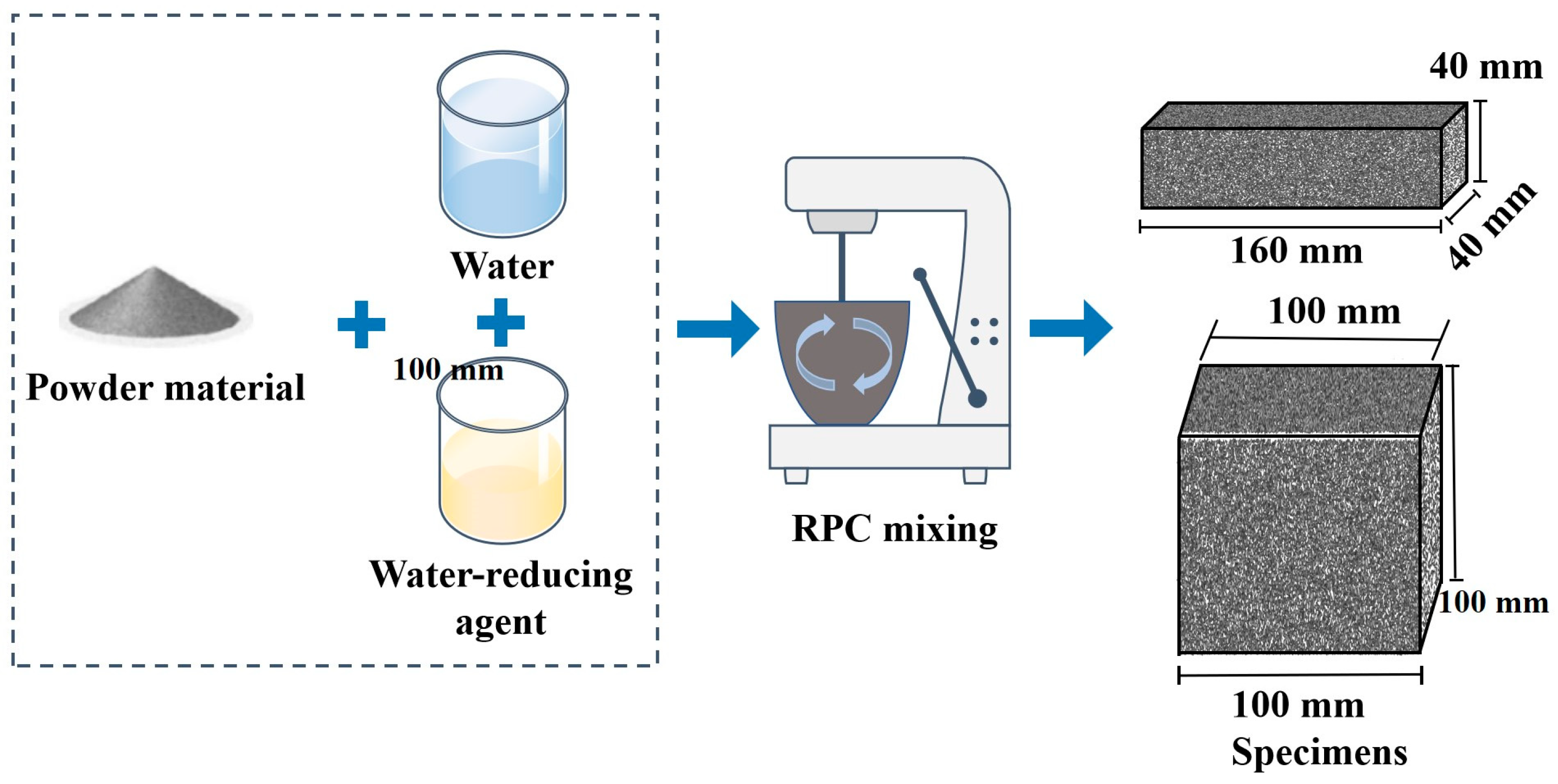
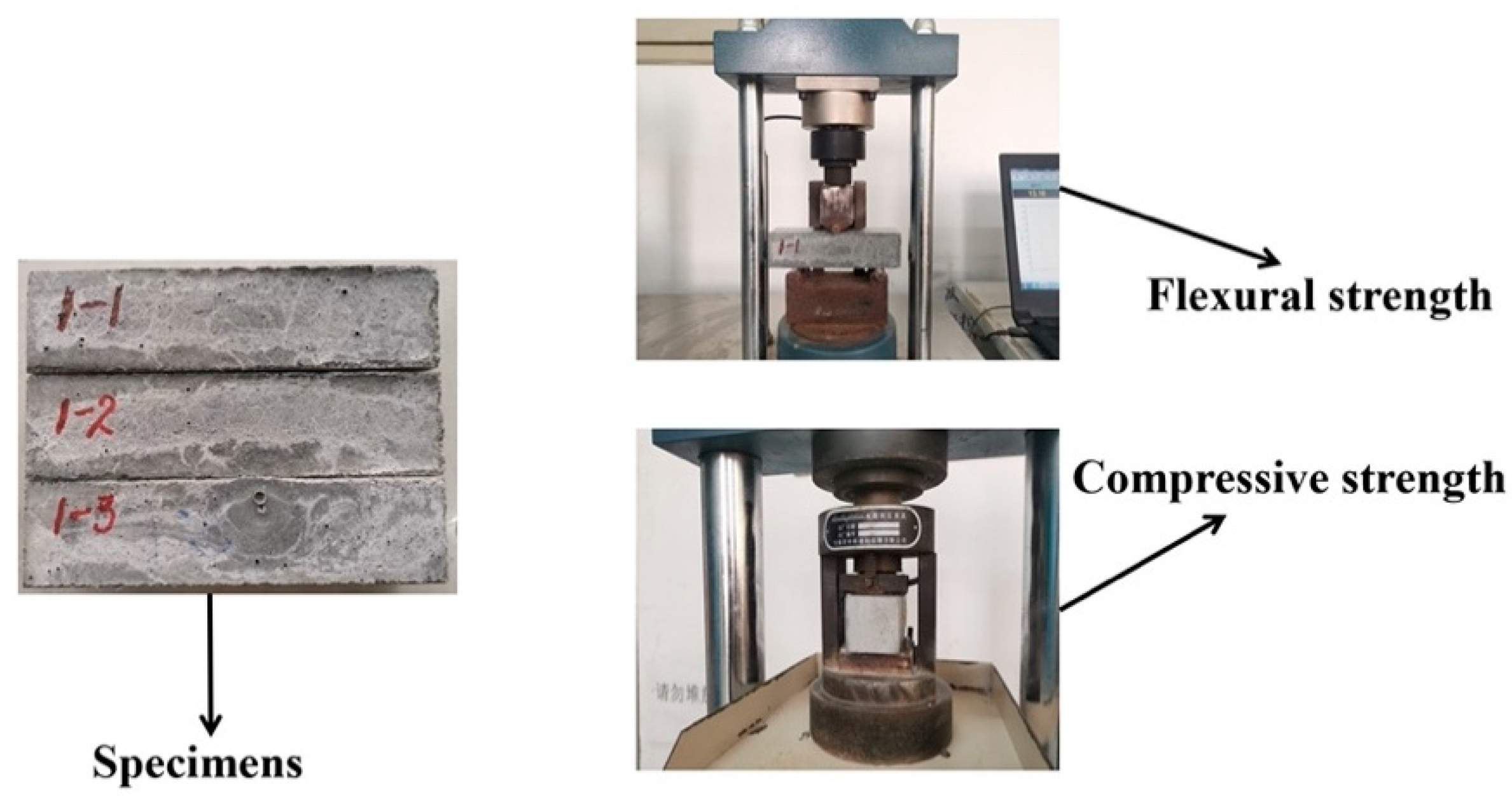


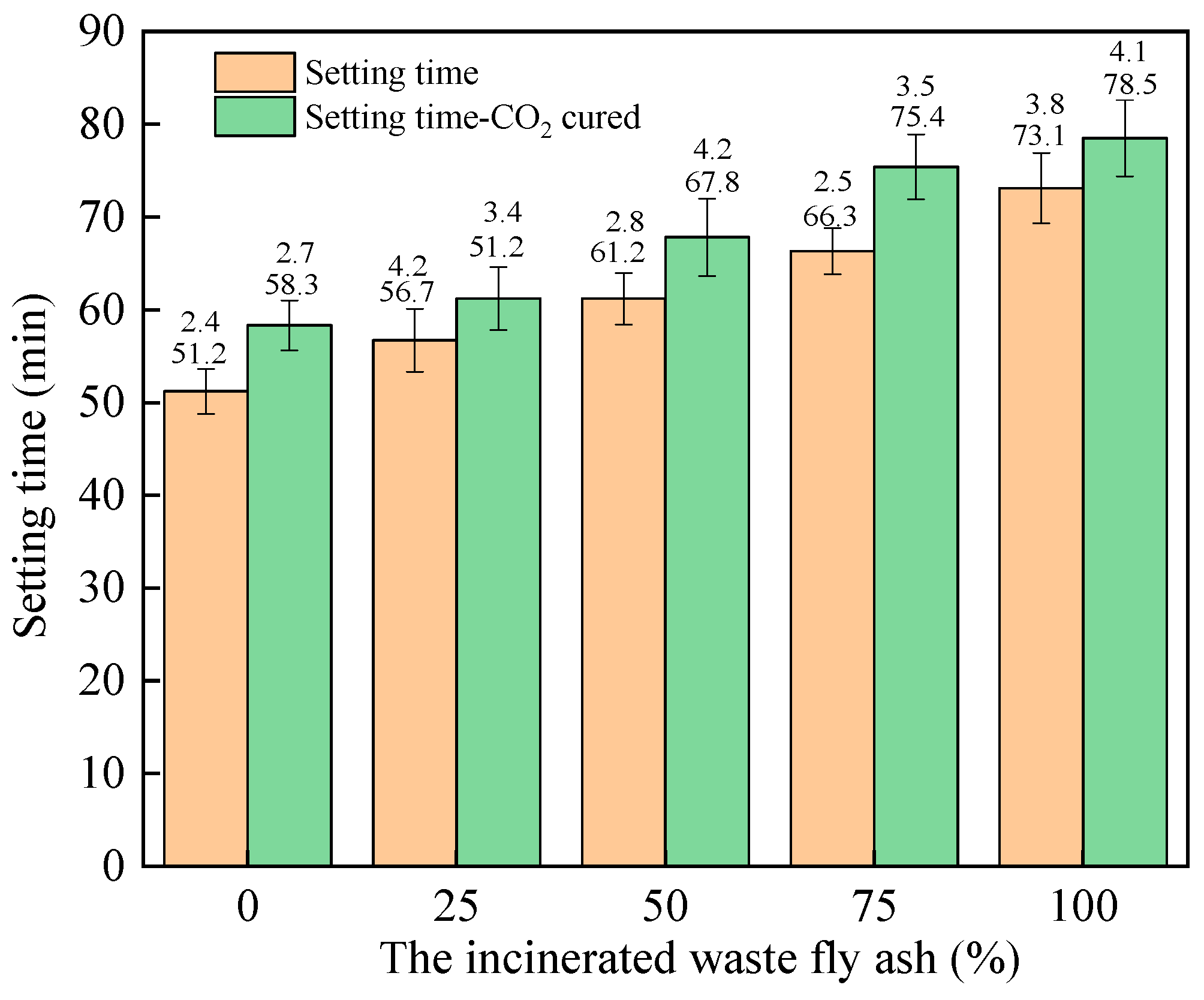
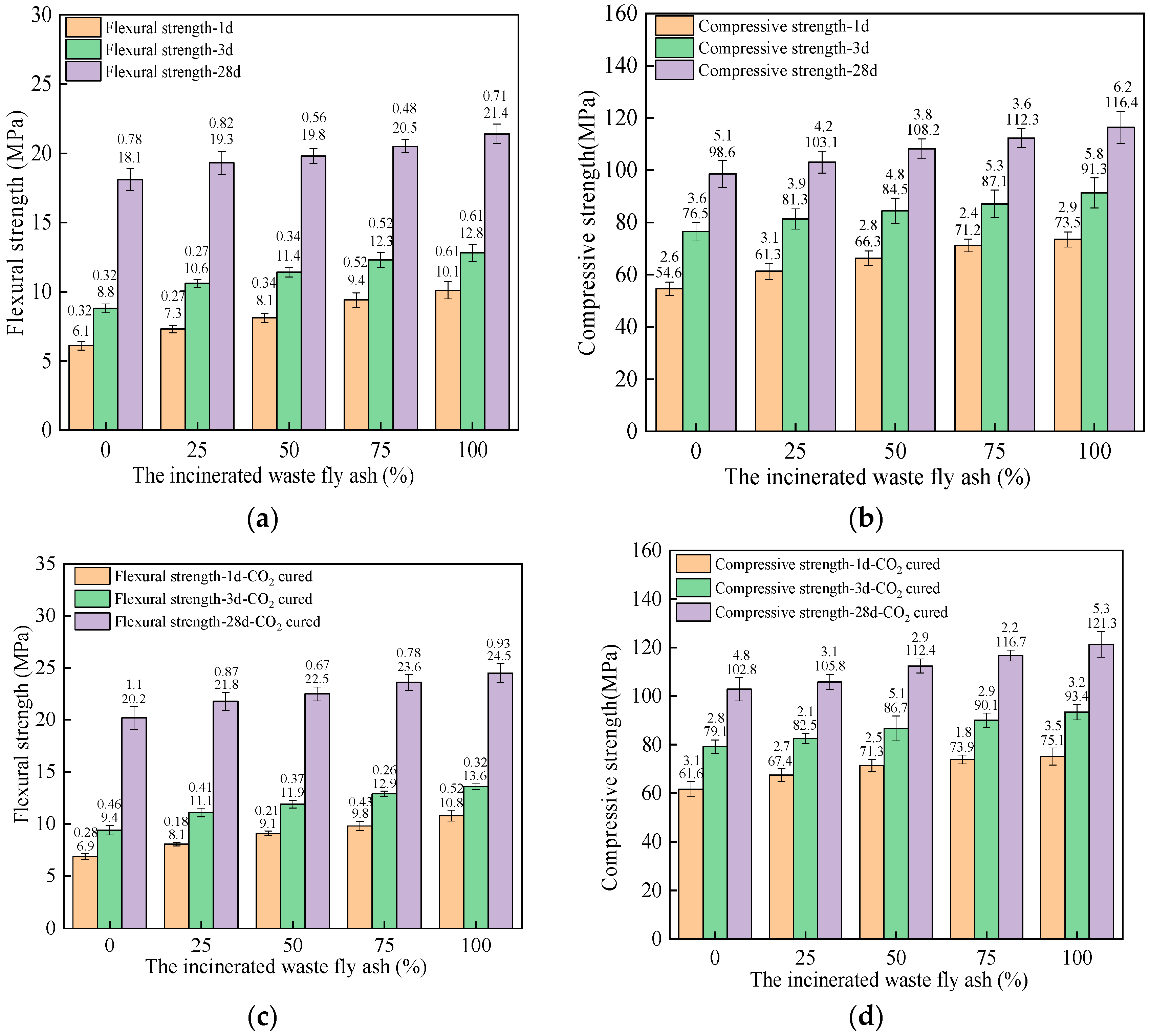
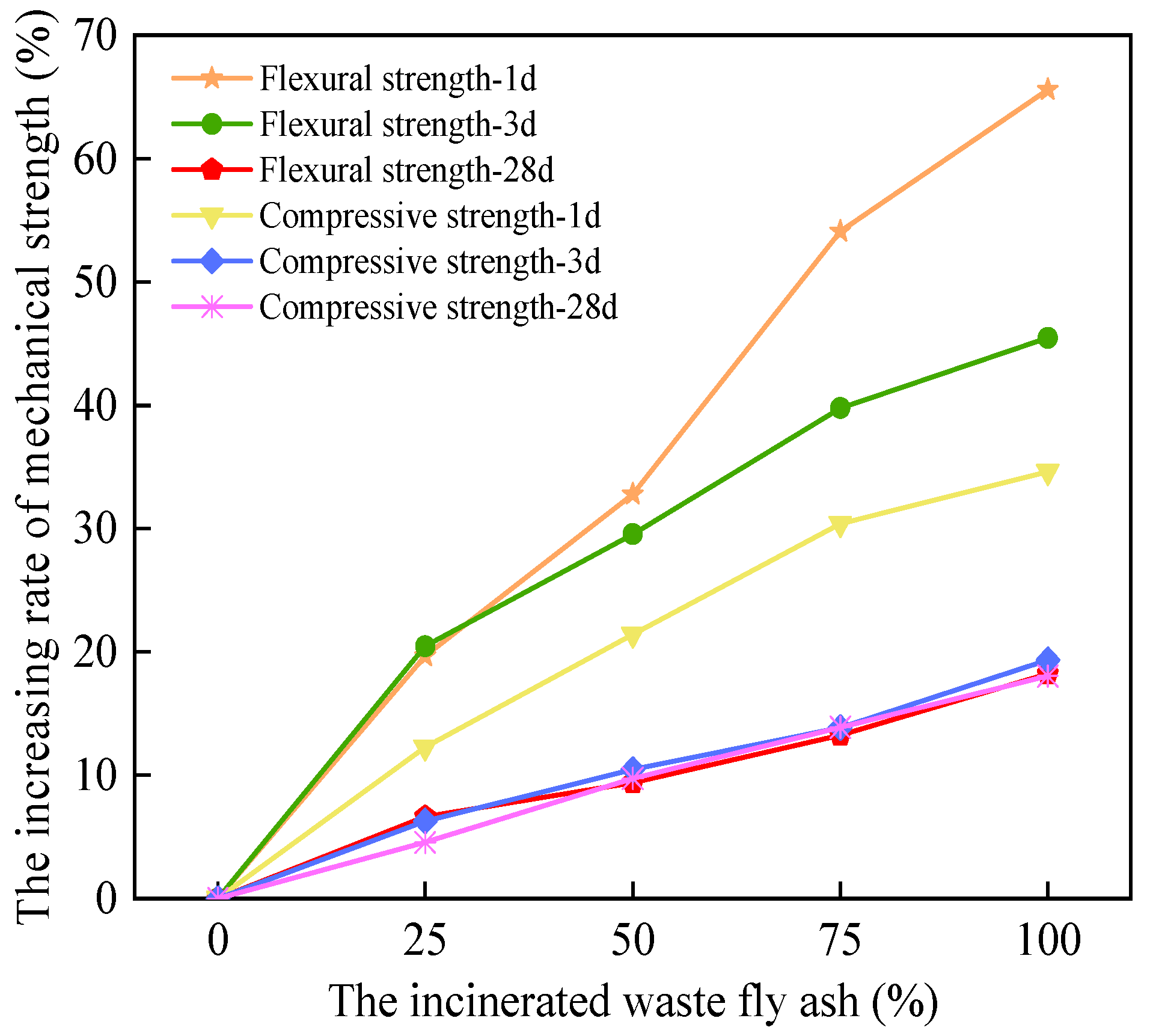
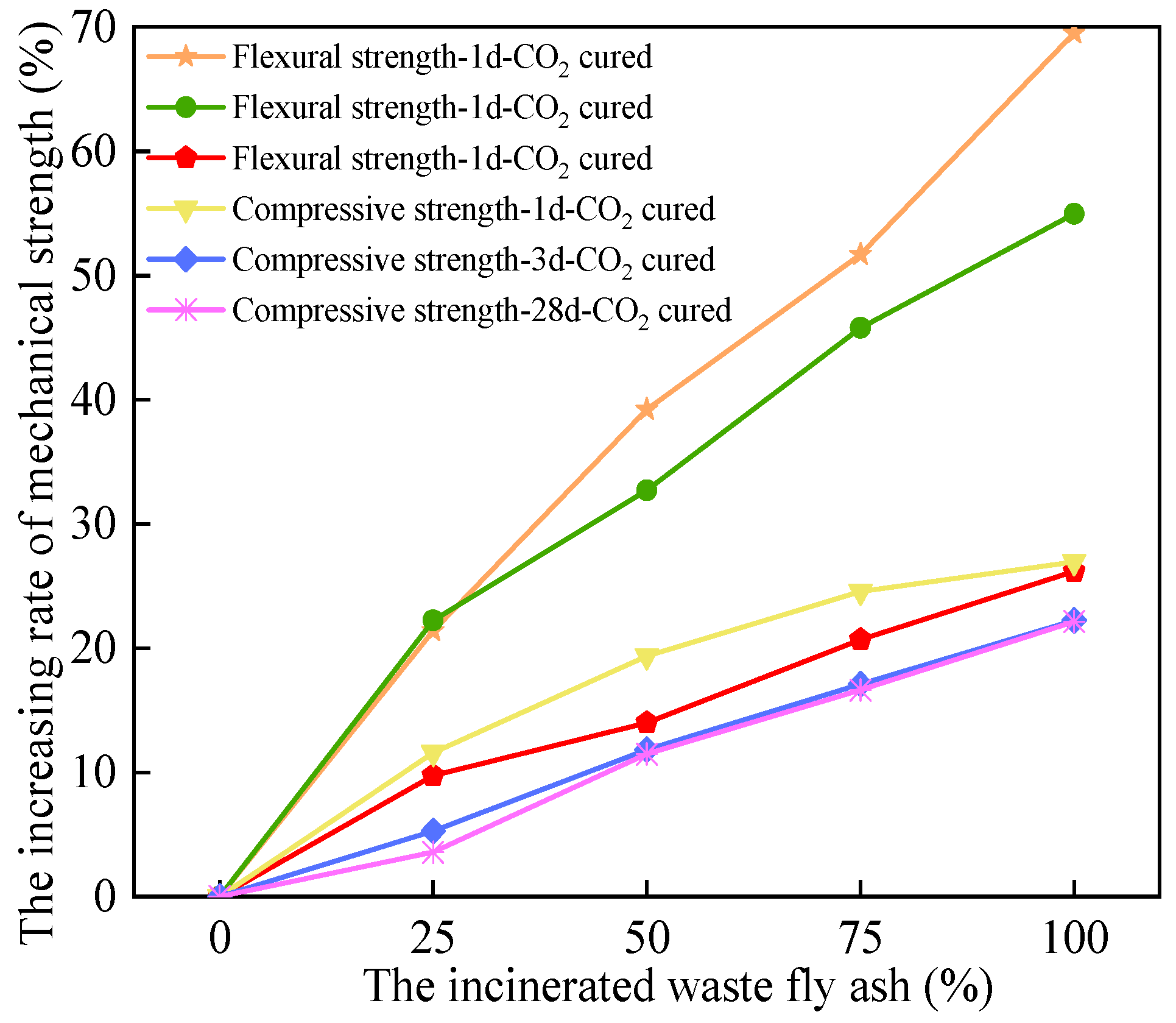
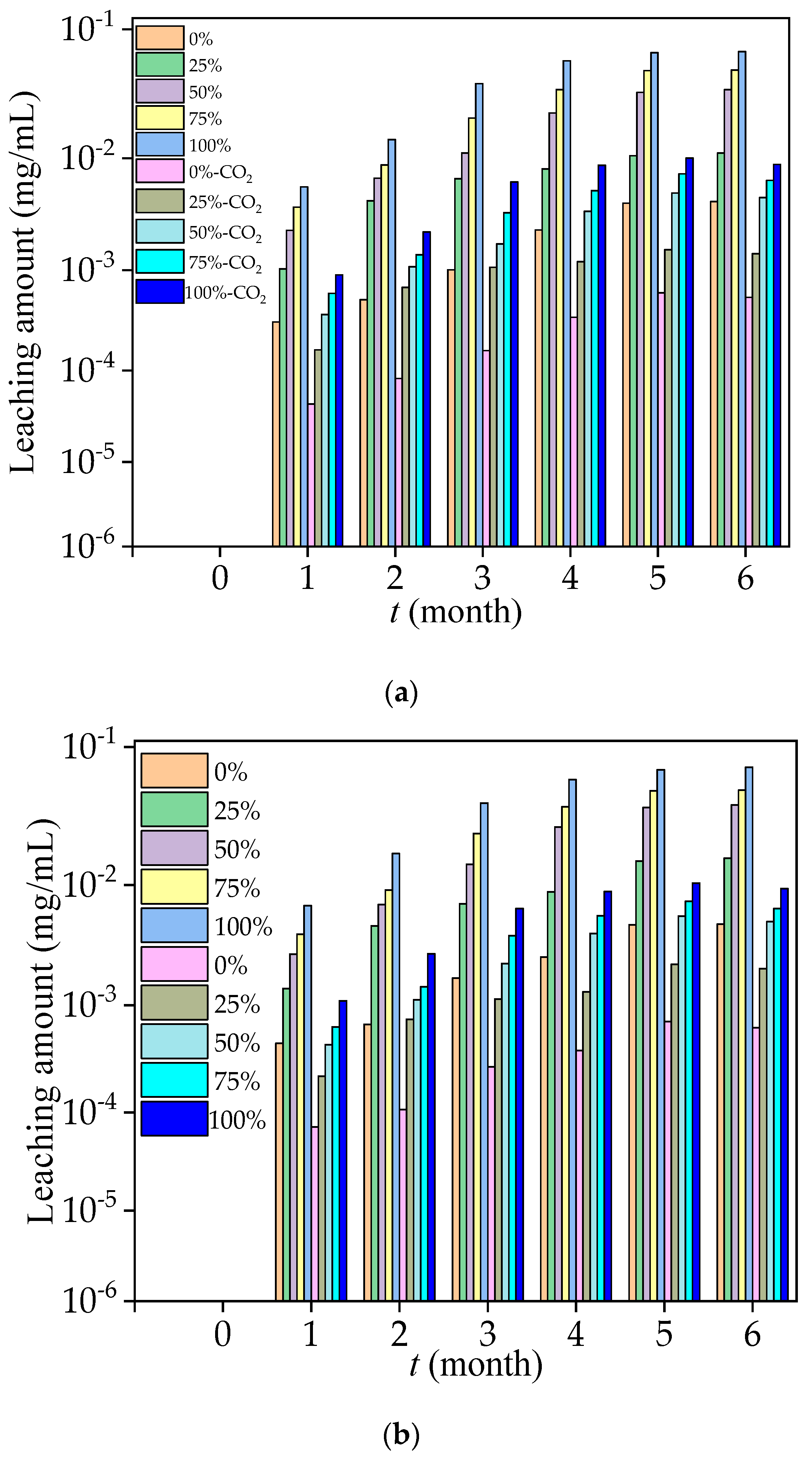
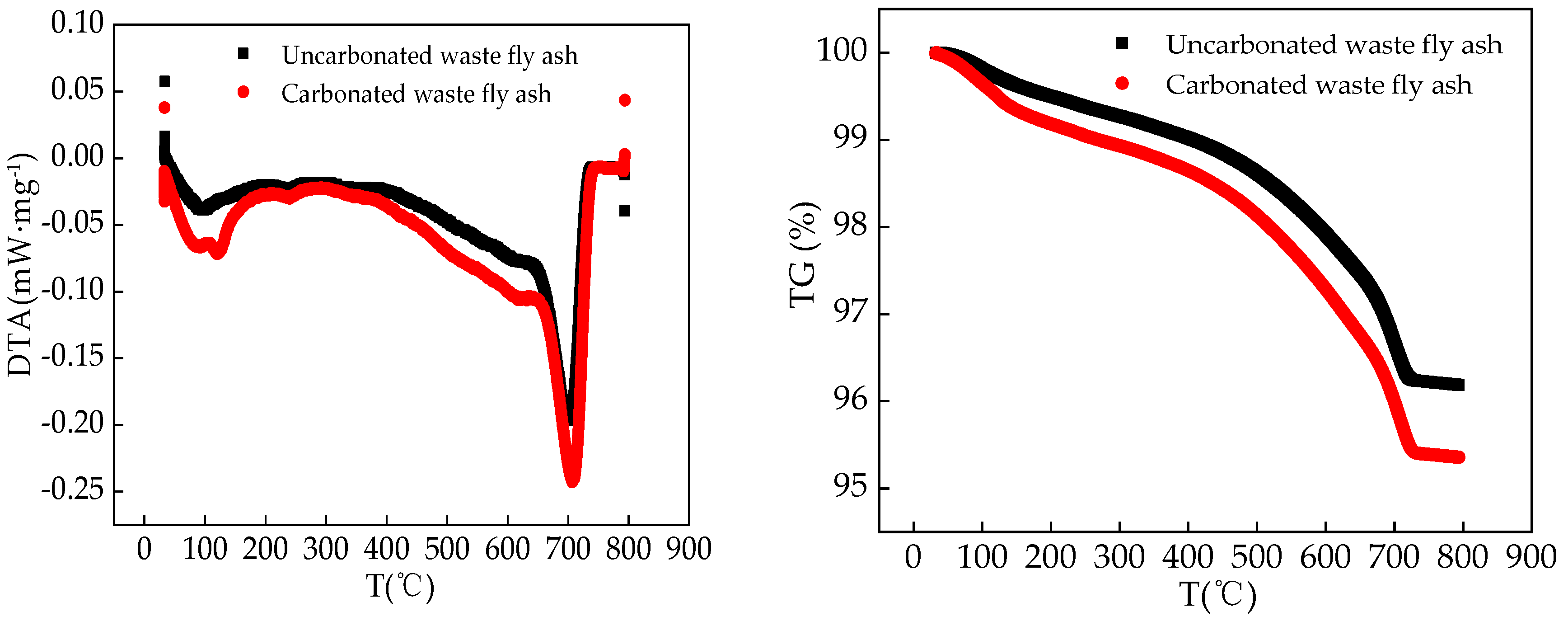
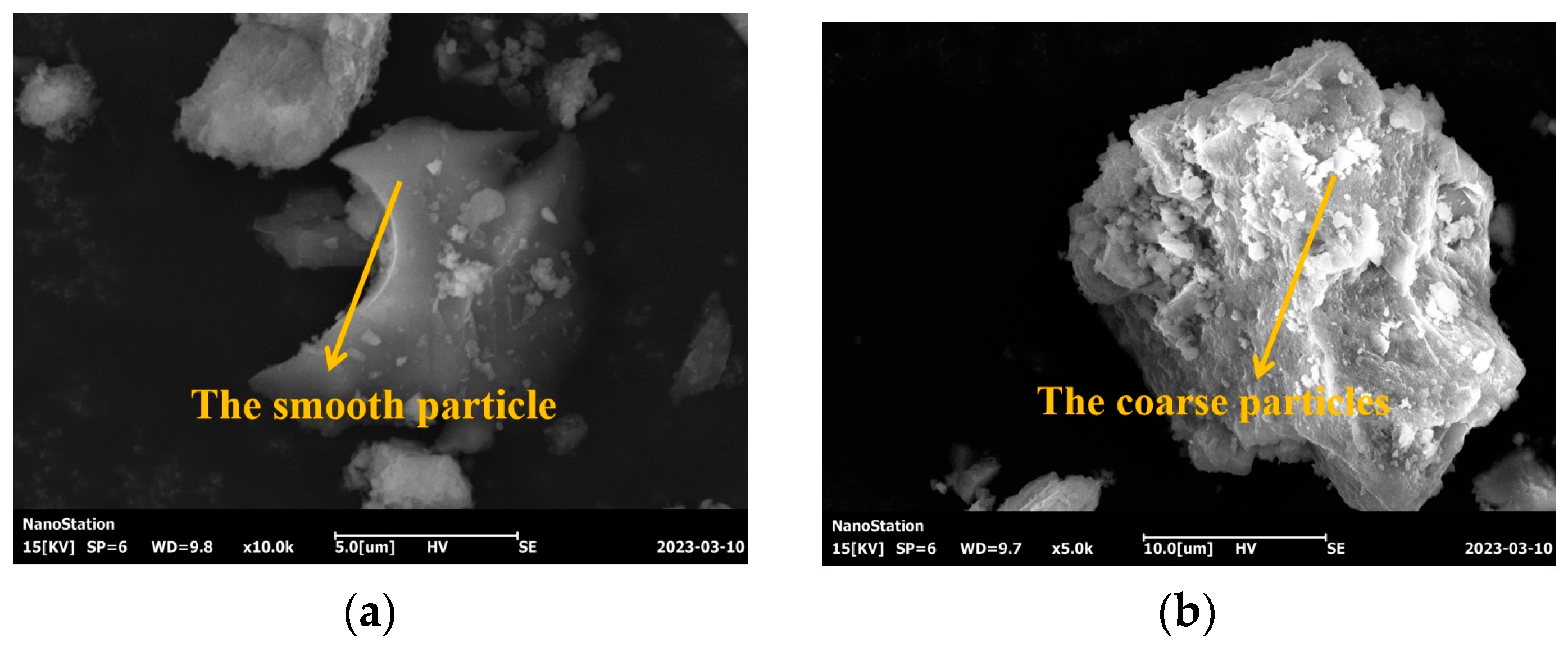
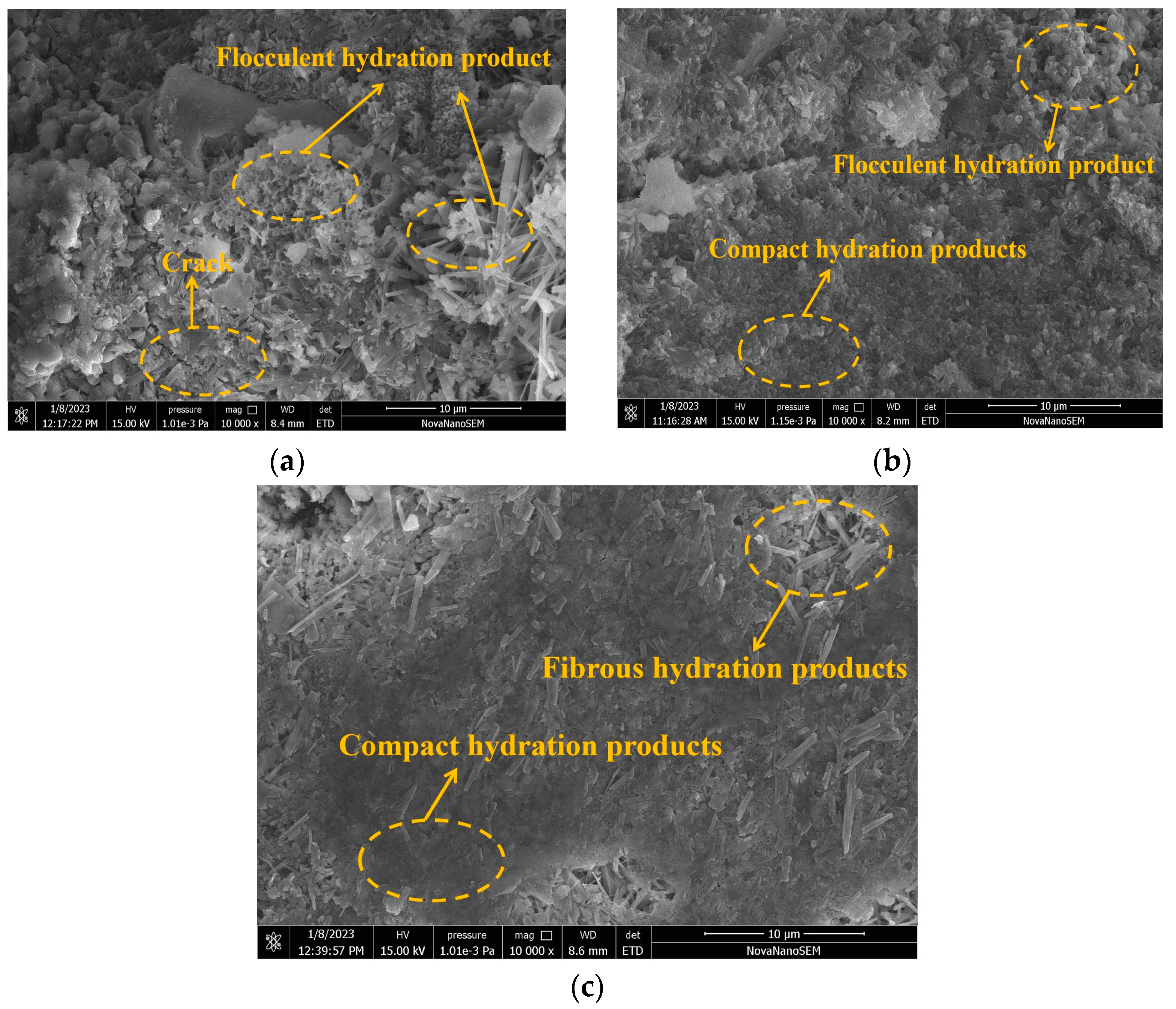
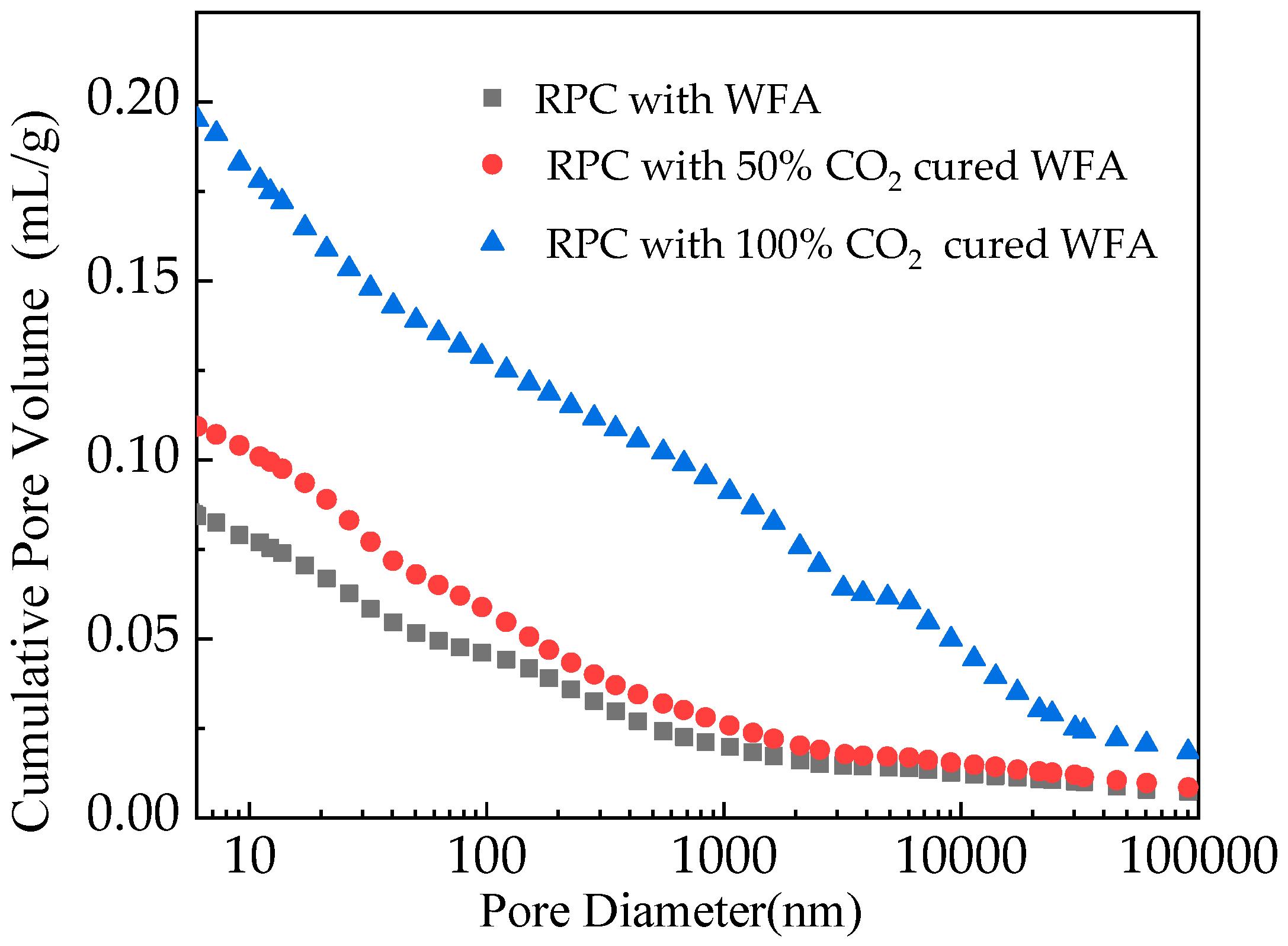
| Types | Particle Size/μm | ||||||
|---|---|---|---|---|---|---|---|
| 0.3 | 0.6 | 1 | 4 | 8 | 64 | 360 | |
| WFA | 0.14 | 0.51 | 2.3 | 17.4 | 31.2 | 97.3 | 100 |
| P·O cement | 0.1 | 0.31 | 2.6 | 15.1 | 28.7 | 93.5 | 100 |
| GGBS | 0.04 | 0.12 | 3.3 | 19.4 | 35.2 | 98.2 | 100 |
| SF | 31.3 | 58.5 | 82.4 | 100 | 100 | 100 | 100 |
| Quartz sand | 0 | 0 | 0 | 0 | 0.04 | 21 | 100 |
| Types | SiO2 | Al2O3 | FexOy | MgO | CaO | SO3 | K2O | Na2O | Ti2O | CdO | Cr2O3 | PbO | CuO | ZnO | Loss on Ignition |
|---|---|---|---|---|---|---|---|---|---|---|---|---|---|---|---|
| WFA | 22.4 | 4.4 | 0.9 | - | 20.2 | 9.56 | 6 | 4.3 | 10.2 | 0.07 | 0.09 | 0.09 | 0.09 | 0.5 | 21.2 |
| P·O cement | 20.8 | 5.6 | 3.8 | 1.8 | 62.1 | 2.8 | - | - | - | - | - | - | - | - | 3.1 |
| GGBS | 34 | 14.9 | 0.5 | 9.8 | 36.9 | 0.3 | 3.6 | - | - | - | - | - | - | - | - |
| SF | 90.8 | 0.21 | 0.62 | 0.23 | 0.44 | 0.2 | 7.5 | - | - | - | - | - | - | - | - |
| Quartz sand | 99.8 | - | 0.2 | - | - | - | - | - | - | - | - | - | - | - | - |
| Water | P·O Cement | WFA | SF | GGBS | Quartz Sand | Water-Reducer |
|---|---|---|---|---|---|---|
| 244.4 | 740.7 | 0 | 370.3 | 111.1 | 977.9 | 16.3 |
| 244.4 | 740.7 | 92.6 | 277.7 | 111.1 | 977.9 | 16.3 |
| 244.4 | 740.7 | 185.2 | 185.2 | 111.1 | 977.9 | 16.3 |
| 244.4 | 740.7 | 277.7 | 92.6 | 111.1 | 977.9 | 16.3 |
| 244.4 | 740.7 | 370.3 | 0 | 111.1 | 977.9 | 16.3 |
Disclaimer/Publisher’s Note: The statements, opinions and data contained in all publications are solely those of the individual author(s) and contributor(s) and not of MDPI and/or the editor(s). MDPI and/or the editor(s) disclaim responsibility for any injury to people or property resulting from any ideas, methods, instructions or products referred to in the content. |
© 2023 by the authors. Licensee MDPI, Basel, Switzerland. This article is an open access article distributed under the terms and conditions of the Creative Commons Attribution (CC BY) license (https://creativecommons.org/licenses/by/4.0/).
Share and Cite
Xu, J.; Wang, H.; Wang, W.; Shi, F. The Influence of CO2-Cured Incinerated Waste Fly Ash on the Performance of Reactive Powder Concrete. Coatings 2023, 13, 709. https://doi.org/10.3390/coatings13040709
Xu J, Wang H, Wang W, Shi F. The Influence of CO2-Cured Incinerated Waste Fly Ash on the Performance of Reactive Powder Concrete. Coatings. 2023; 13(4):709. https://doi.org/10.3390/coatings13040709
Chicago/Turabian StyleXu, Jianhu, Hui Wang, Wanzhen Wang, and Feiting Shi. 2023. "The Influence of CO2-Cured Incinerated Waste Fly Ash on the Performance of Reactive Powder Concrete" Coatings 13, no. 4: 709. https://doi.org/10.3390/coatings13040709
APA StyleXu, J., Wang, H., Wang, W., & Shi, F. (2023). The Influence of CO2-Cured Incinerated Waste Fly Ash on the Performance of Reactive Powder Concrete. Coatings, 13(4), 709. https://doi.org/10.3390/coatings13040709







